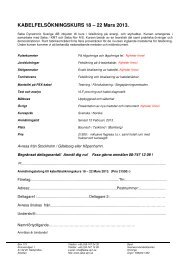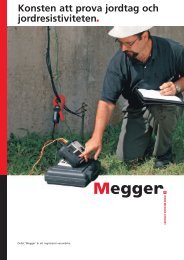A practical guide to earth resistance testing - Weschler Instruments
A practical guide to earth resistance testing - Weschler Instruments
A practical guide to earth resistance testing - Weschler Instruments
Create successful ePaper yourself
Turn your PDF publications into a flip-book with our unique Google optimized e-Paper software.
Introduction<br />
Nothing is quite so common or abundantly available throughout the world<br />
as the <strong>earth</strong>’s soil. We are more apt <strong>to</strong> think of <strong>earth</strong> as something <strong>to</strong> be<br />
tilled for planting or <strong>to</strong> be excavated for a building foundation. Yet, it also<br />
has an electrical property -- conductivity (or low <strong>resistance</strong>) -- that is put <strong>to</strong><br />
<strong>practical</strong> use every day in industrial plants and utilities.<br />
Broadly speaking, “<strong>earth</strong> <strong>resistance</strong>” is the <strong>resistance</strong> of soil <strong>to</strong> the<br />
passage of electric current. Actually, the <strong>earth</strong> is a relatively poor<br />
conduc<strong>to</strong>r of electricity compared <strong>to</strong> normal conduc<strong>to</strong>rs like copper<br />
wire. But, if the area of a path for current is large enough, <strong>resistance</strong><br />
can be quite low and the <strong>earth</strong> can be a good conduc<strong>to</strong>r. It is the <strong>earth</strong>’s<br />
abundance and availability that make it an indispensible component of a<br />
properly functioning electrical system.<br />
Earth <strong>resistance</strong> is measured in two ways for two important fields of use:<br />
1. Determining effectiveness of “ground” grids and connections that are<br />
used with electrical systems <strong>to</strong> protect personnel and equipment.<br />
2. Prospecting for good (low <strong>resistance</strong>) “ground” locations, or obtaining<br />
measured <strong>resistance</strong> values that can give specific information about what<br />
lies some distance below the <strong>earth</strong>’s surface (such as depth <strong>to</strong> bed rock).<br />
It is not the intent of this manual <strong>to</strong> go <strong>to</strong>o deeply in<strong>to</strong> the theory and<br />
mathematics of the subject. As noted in the references at the end,<br />
there are many excellent books and papers that cover these. Rather, the<br />
information herein is in simple language for easy understanding by the<br />
user in industry.<br />
From years of experience in supplying instruments for the tests involved,<br />
Megger can provide advice <strong>to</strong> help you make specific tests. We would be<br />
pleased <strong>to</strong> have a representative call on you <strong>to</strong> discuss your application.<br />
©2010 Megger<br />
Getting Down <strong>to</strong> Earth 1




